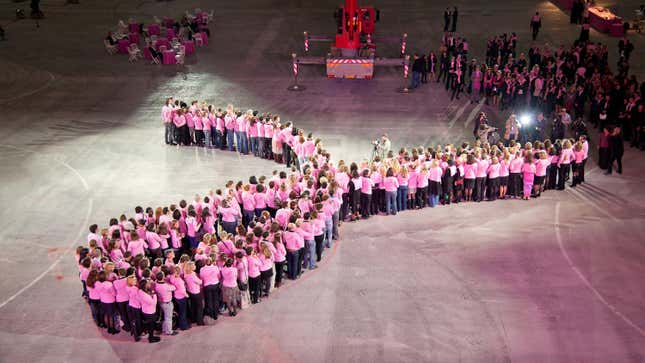We’re All ‘Aware’ of Breast Cancer. It’s Time to Do More.
With one in eight women diagnosed in their lifetime, what we need is less pink and more action.
In Depth

When Katie Couric announced recently that she’d been diagnosed with early stage breast cancer, I whooped, “Hallelujah!” To be clear, my excitement was not about her having a life-threatening disease, rather that a famous person with a huge platform was sharing her story in the hopes that women everywhere would take heed and, more importantly, take action. “Please get your annual mammogram,” Couric wrote in an essay on her website. “I was six months late this time. I shudder to think what might have happened if I had put it off any longer.”
With October and its tired barrage of played-out pink ribbons upon us, Couric’s timing couldn’t have been better. Her story will save more lives than the pink-washing of ten Octobers ever could.
Over the past decade, countless companies have jumped on the pink wagon by incorporating the color into their October marketing, knowing full well that the average consumer won’t ask what portion of proceeds (if any) actually goes towards research and patient care. The NFL “celebrated breast cancer awareness” in 2012 by outfitting players in pink cleats, gloves, and towels (but missed a perfectly good opportunity to promote manual self-exams by referring to touchdowns as “feel downs,” if you ask me). Danica Patrick posed next to a pink Chevy she’d be racing in support of awareness, KFC launched an absurd campaign called “Buckets for the Cure,” and Delta Airlines painted huge pink ribbons on its planes. (The irony that some of these companies make carcinogenic products gets lost amidst the pink.) Breast Cancer Awareness Month is played out, and I propose that we eliminate it all together. In fact, I think it’s actually hurting, not helping, the cause by being so easy to ignore.
“It’s almost like people become desensitized to all the pink and have a ‘yes, breast cancer is bad, but it’s not happening to me’ attitude about it,” Emily Goldberg, head genetic counselor at JScreen, told me. JScreen’s aim is to get people to have genetic testing done, which would allow them to make better health decisions. “And for all the amazing educational events out there, it’s so much jammed into one month that things get lost and people get burned out; they tune it out.”
-

-

-

-

-

-

-

-

-

-

-

-

-

-

-

-

-

-

-

-

-

-

-

-

-

-

-

-

-

-

-

-

-

-

-

-

-

-

-

-








































